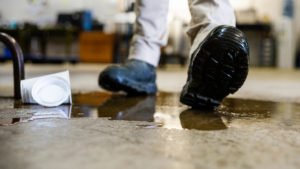slips, trips and falls
Stop slips with my top 19 tips

September is ‘Sliptember’, a month-long campaign to raise awareness around slip safety. In the second of two articles, SHP hears from its founder, Christian Harris, on his top tips for preventing slips at work.
Over the course of Sliptember, I’ve created a series of videos about CHIMES – the six reasons people slip (you can find these on LinkedIn). Below are my top three tips for each of the six CHIMES, that you can use to reduce your slip risk (plus a bonus 19th tip to guide you on where to start).
 Contamination
Contamination
- Conduct a comprehensive building audit to assess different zones and their respective levels of contamination, enabling you to create tailored cleaning plans.
- Implement preventative measures such as strategically placed drip trays and umbrella bags to reduce floor contamination from the start.
- Evaluate your floor’s threshold for contamination to accurately gauge the level of risk. The viscosity of contaminants and the roughness of floors are the key parameters.
Heel
- Make it a point to understand the slip-resistance level of your current footwear; the material and design of the sole are pivotal.
- Regularly inspect your footwear for signs of wear and tear. Update them before the sole becomes excessively smooth and, consequently, slippery.
- Ensure that staff consistently wear the slip-resistant shoes provided. Zero in on aspects like comfort and aesthetic appeal to encourage usage.

Individual
- Know your building’s users well. If they are predominantly older, the likelihood of slips and more severe injuries substantially increases.
- Carefully assess the activities occupants are engaged in; complex actions like rushing, carrying, or twisting heighten the risk of slipping – can these be managed out?
- If you find the need to use wet floor signs beyond a) pre-planned cleaning times or b) whilst temporarily dealing with a spillage, this is a red flag indicating unresolved slip hazards.
Maintenance
- Take time to revisit your building’s original design intentions. Assess if any modifications or usage changes have introduced unforeseen slip risks.
- Carry out a thorough floor audit to identify areas of wear and tear, particularly spots that have grown smoother, thus elevating the risk of slips.
- Your floors are being cleaned, but are they being cleaned effectively? Grab a white paper towel, spray some water on the floor, then rub the towel into it. If it doesn’t come up pristinely clean, you may have a cleanliness therefore slip issue.
Environment
 Conduct a user-centric walkthrough of your building to spot potential distractions that could contribute to slips and falls.
Conduct a user-centric walkthrough of your building to spot potential distractions that could contribute to slips and falls.- Download the Angle Pro app to meticulously measure floor angles, revealing any subtle inclines, ramps, or slopes that might be easily overlooked.
- Utilise the Measure app to accurately gauge the depth of entrance matting, a crucial element in preventing slips at entry points. For a peak traffic flow of 400 people per hour, you should have 6-7 metres of matting. Most buildings have under 1 metre…
Surface
- Your floors may not be as slip safe as you assume. Either, they were anti-slip but have changed over time.
- Or, they were anti-slip but are no longer due to being dirty.
- Or, perhaps they never were anti-slip to start with (just because a floor has a texture doesn’t mean its actually safe when wet). Get a slip test to scientifically measure your floor safety.
Score yourself to discover where to start
- Receive a score for your building’s current performance in each of the CHIMES using our self-assessment Scorecard quiz – Slip Prevention Scorecard: https://scorecard.slipsafety.co.uk/
For additional information, please register for one of my regular “Introduction to Slipology” webinars here.
Join the movement by following me on LinkedIn here: https://www.linkedin.com/in/christian-harris-slip-safety. You can enter the prize draw here (https://sliptember.slipsafetyservices.com/) or simply by using the hashtag #sliptember throughout September.
Approaches to managing the risks associated Musculoskeletal disorders
In this episode of the Safety & Health Podcast, we hear from Matt Birtles, Principal Ergonomics Consultant at HSE’s Science and Research Centre, about the different approaches to managing the risks associated with Musculoskeletal disorders.
Matt, an ergonomics and human factors expert, shares his thoughts on why MSDs are important, the various prevalent rates across the UK, what you can do within your own organisation and the Risk Management process surrounding MSD’s.
Stop slips with my top 19 tips
September is ‘Sliptember’, a month-long campaign to raise awareness around slip safety. SHP hears from its founder, Christian Harris, on his top tips for preventing slips at work.
Christian Harris
SHP - Health and Safety News, Legislation, PPE, CPD and Resources Related Topics
New Zealand landowner company found guilty over volcano disaster
Unsafe and potentially dangerous ladders are being sold online – experts have warned
Metalworkers concern over lack of health and safety priorities

 Contamination
Contamination
 Conduct a user-centric walkthrough of your building to spot potential distractions that could contribute to slips and falls.
Conduct a user-centric walkthrough of your building to spot potential distractions that could contribute to slips and falls.
Proactive measures has to be taken in addition to PPE!